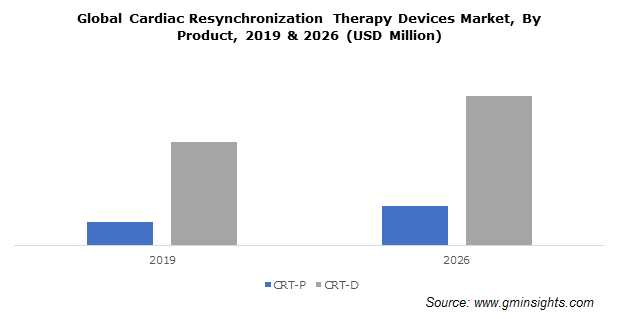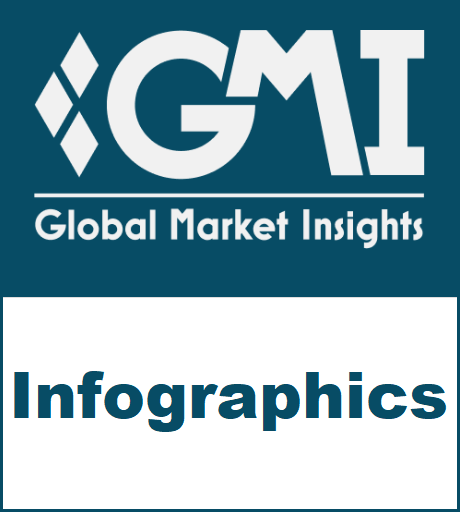Home > Pressrelease > CRT Devices Market size to exceed $3 Bn by 2026
CRT Devices Market size to exceed $3 Bn by 2026
- Published Date: March 19, 2020
CRT Devices Market size is set to exceed USD 3 billion by 2026; according to a new research report by Global Market Insights Inc.
A growing geriatric population across the globe will drive the market expansion. Geriatric population shows an increased incidence of cardiac disorders, requiring medical intervention. Also, due to increased life-expectancy, there is an emphasis on improved quality of life for seniors.
Unhealthy lifestyle habits will positively impact the market growth
Unhealthy habits such as a sedentary lifestyle, rising adoption of smoking and consumption of junk food have been linked to increased incidence of cardiac diseases. Also, these lifestyle habits often result in metabolic diseases which increase the probability of comorbidities such as heart failure, and arrhythmias. According to the WHO, in 2019, about 1.1 billion people across the world were smokers, majority of them living in the low-middle income countries. Smoking has been linked to a significant number of heart disorders including increased risk of heart failure and arrhythmias. Hence, a growing adoption of unhealthy habits coupled with increase in significant number of smokers is expected to augment the CRT devices market expansion.

Get more details on this report - Request Free Sample PDF
Favorable reimbursement scenario will drive the adoption rate
A favorable reimbursement scenario is expected to drive the adoption rate of cardiac resynchronization therapy devices. For instance, Medicare reimburses the cost of a CRT device if its deemed medically necessary. Also, there is no Local Coverage Determination (LCD) that limits the coverage to any patient meeting the criteria for implantable cardioverter defibrillator (ICD). This scenario will enable Medicare patients to undergo surgery for implantation of ICDs, boosting the product demand.
Browse key industry insights spread across 200 pages with 592 market data tables & 14 figures & charts from the report, “Cardiac Resynchronization Therapy (CRT) Devices Market Size By Product (CRT-P {MRI Compatible CRT-P Devices, Conventional CRT-P Devices}, CRT-D {MRI Compatible CRT-D Devices, Conventional CRT-D Devices}), By Age (Below 44 Years, 45- 64 Years, 65-84 Years, Above 85 Years), By End-use (Hospitals, Cardiac Care Centers, Ambulatory Surgical Centers), Industry Analysis Report, Regional Outlook, Application Potential, Competitive Market Share & Forecast, 2020 – 2026” in detail along with the table of contents:
https://www.gminsights.com/industry-analysis/cardiac-resynchronization-therapy-crt-devices-market
Increased incidence of cardiovascular disorders will drive CRT-P segment growth
The CRT-P segment held significant market value in 2019 and is poised to exhibit 7.1% CAGR during 2020 to 2026. An increased incidence of arrhythmias due to unhealthy lifestyle habits will spur the demand for cardiac resynchronization therapy-pacemaker devices. Furthermore, favorable reimbursement scenario will drive the adoption rate, propelling segment expansion.
CRT-D devices segment held nearly USD 1.7 billion CRT devices market value in 2019 and will display substantial growth over the forecast period. The high growth can be attributed to the rising geriatric population and the increased lifespans in the population. Furthermore, technological advancements in CRT-D devices such as quadripolar leads and MRI compatibility will boost the adoption rates.
65-84 year-old patients will dominate the market share owing to an increased incidence of cardiac ailments
The 65-84 year patient segment held nearly 58% market share in 2019 and will exhibit robust growth over the forecast time period. The rising number of geriatric individuals across the globe will propel the segment growth. According to the WHO, the number of people over 60 years of age is expected to more than double by 2050. This will positively impact the demand for CRT devices and propel the market expansion.
Patient segment of people above 85 years of age will exhibit 6.3% CAGR over 2020 to 2026. An increasing lifespan across the globe, coupled with growing emphasis on quality of life for seniors will push the CRT devices market growth.
Quality of care in hospitals will boost segment growth
Hospital segment held nearly 46% CRT devices market share in 2019. The presence of qualified surgeons in hospitals will increase the number of surgeries performed in hospitals. Also, high quality of post-operative care will drive the segment expansion. Additionally, there has been an increase in number of hospitals, especially in developing regions. Government initiatives to improve the healthcare infrastructure have pushed the market growth. Thus, there will be a significant increase in demand for cardiac resynchronization therapy devices from hospitals. These factors will have a positive impact on the overall market growth.
Growing obesity in North America will be conducive to regional market growth
North America was valued at nearly USD 1 billion in 2019. North America region held the majority market share and will witness substantial growth during the forecast period. The growing rates of obesity in the region will contribute to the market growth. Obesity is often accompanied by comorbidities such as heart failure and inefficient heart function, which will also drive the market demand.
U.S. CRT devices market will exhibit 5.7% CAGR during 2020 to 2026. The growth can be attributed to the growing rates of metabolic diseases such as obesity, and diabetes. An unhealthy lifestyle, increased alcohol consumption, and smoking will increase the patient pool in the region. These factors will drive the demand for cardiac resynchronization therapy devices in the U.S. Furthermore, presence of major manufacturers in the region will drive the industry expansion in the country.
Companies implement several innovative strategies to capture market share
Some notable manufacturers of cardiac resynchronization therapy devices include Abbott, Medtronic, Boston Scientific, Microport Scientific, and Biotronik. The manufacturers are engaged in R&D to launch innovative products in a bid to increase the market share. Acquisitions and partnerships are some inorganic growth strategies utilized by these companies. For instance, in April 2019, Biotronik announced the launch of Acticor DX and CRT-DX ICD devices in the U.S. This launch has helped Biotronik in expanding the customer base for their ICD products and increasing their customer base.
Explore More on Related Topics:
